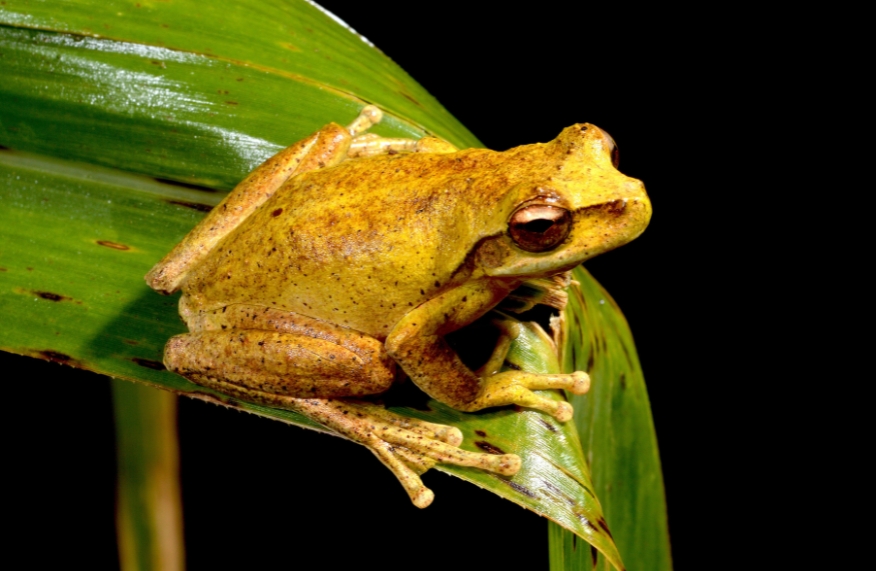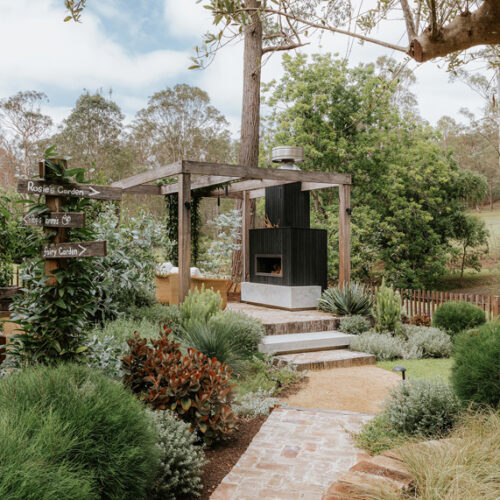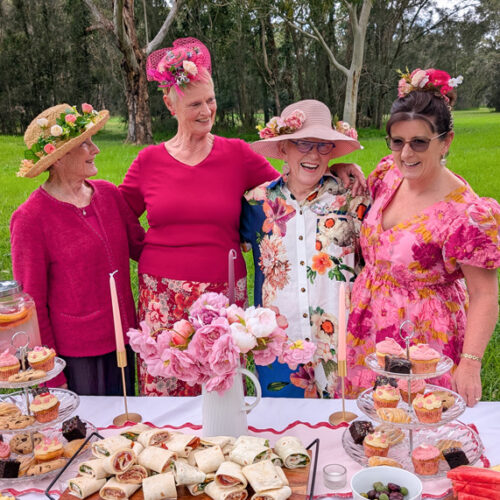Create a frog-friendly backyard and help save frogs
2025-11-07T16:27:38+11:00
Frog ID week is Australia’s biggest annual frog count event. Here, Dr. Jodi Rowley from the Australian Museum – conservation biologist and lead scientist for FrogID – talks about its significance and shares her tips for transforming your backyard into a frog haven!
The Australian Museum’s popular FrogID Week returns for its eighth year, running from Friday, November 7 to Sunday, November 16, 2025. Keen citizen scientists can record frog calls on their smartphones using the free FrogID app. These recordings help scientists and conservationists track frog populations and distributions over time, providing insights into how frogs and their ecosystems are responding to a changing planet. While you can record frogs at any time of the year, FrogID Week gives an intensive snapshot of frogs across Australia – plus, species such as the Atherton Tablelands whirring frog (Litoria corbeni), shown above, are often at their noisiest this time of year.
Australia is home to over 250 known native frog species and many are under threat. Sensitive to environmental changes, frogs serve as bio-indicators: declining populations warn us that ecosystems are under stress. “Frogs are really important cumulative cogs in the wheel”, says Dr. Jodi Rowley, conservation biologist and Curator of Amphibian and Reptile Conservation Biology at the Australian Museum. “Frogs are really important in energy flows, nutrient dynamics and food webs. Tadpoles help keep the algae at bay, the adults eat literally tons of invertebrates including pest species and frogs are also delicious food for a lot of other animals.”
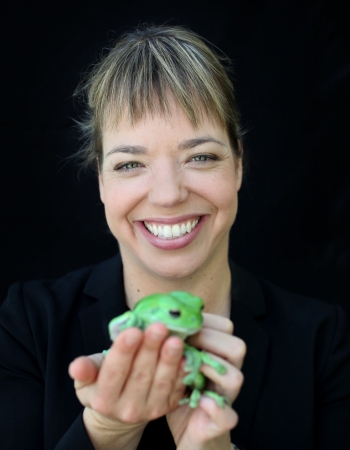
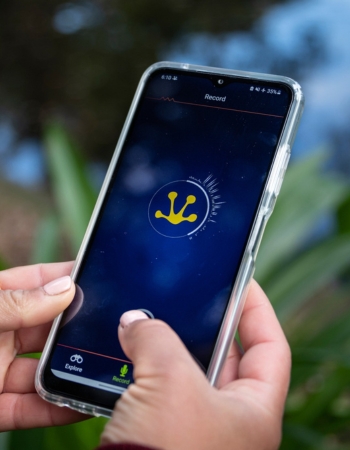
Record your local frogs!
How? Download the free app by the Australian Museum, called FrogID. Whenever you hear frogs calling, press record for at least 20 seconds and submit it. “The time, date, and location is all automatic. You don’t need to know what species of frog is calling, which is a big help,” says Jodi. “We then listen to those recordings and identify all the frog species calling. You’ll also get notified so you get to learn what your local frogs are.”
How often? Jodi encourages people to record as much as possible – even every night if you want! “It’s only by getting this fine scale kind of data that we can understand the true impacts of climate change.”
Do my recordings actually make a difference? YES! Every recording contributes to a national database that now holds over 1.4 million frog records from across Australia — the largest of its kind anywhere in the world. “It has really revolutionised our understanding of frogs,” says Jodi. “The data has been used to study the effects of drought, the impacts of the Black Summer bushfires, and how frogs are responding to habitat changes. It’s even helped scientists describe 13 new frog species in Australia, which is pretty awesome!”
Jodi adds that the data has also revealed that frogs in urban areas have longer breeding seasons. “It’s only because of people recording frogs in their backyards every day that we’ve been able to figure this out.”
Jodi’s tips for a frog-friendly backyard
One of the biggest challenges frogs face is habitat modification. “We make gardens that sometimes aren’t super frog friendly. In fact, 8 in 10 frog species in Australia don’t do well when we start to modify the environment,” says Jodi. “We can make some really small changes to bring frogs to our environment.” Here, she shares some simple ways to make your garden frog-friendly.
- Build a pond. “It doesn’t have to be big at all. There are a lot of frogs that live in suburban environments with small ponds,” says Jodi. Depending on the size of your space, you could include a shallow dish, small pond or frog bog.
- Create chill out zones. “If you’re not interested in having a place where frogs can breed, then just provide them a general place to hang out,” says Jodi. Use native vegetation, bushes, logs and plenty of nooks for frogs to shelter. “Frogs can move quite a lot. Some species can move a kilometre in a night! So just because you don’t have frogs breeding in your backyard, doesn’t mean they’re not visiting.”

- Make a frog hotel. Frog hotels are ideal for tree frogs (Litoria species), which use their sticky toe pads to cling to smooth surfaces. Frog hotels are generally made out of pvc pipes stuck upright in the ground, providing a dark and moist space for tree frogs to sleep.

- Keep frogs safe. Keep your cat indoors, particularly at night and avoid using any pesticides or chemicals in the garden. “Frogs don’t drink with their mouths, they absorb water through their bellies and so they will suck up any chemicals they happen to put their bellies against as they’re bouncing around,” says Jodi.

How to create a frog pond
- Download the FrogID app and use the ‘Near Me’ filter to find out which frog species are local to your area. This will help you determine what kind of pond to create and how to support their unique habitat needs.
- Choose a spot for your pond that’s not too close to the house – frogs can be quite noisy – and away from large trees, as their roots can cause issues. Make sure the area also receives enough sunlight for plants to thrive.
- Choose the type of frog habitat you want to build:
– Liner frog pond. Create shallow (10-30cm) and deep (50-70cm+) areas of water. Add in rocks, hollow logs and plants, so your frogs can easily get out. Add mulch, leaf litter, rocks and logs around the outside to give your frogs places to hide and if you use a plastic liner, make sure it’s not easily punctured.
– Above ground frog pond. Check your chosen container is watertight and has not contained harmful chemicals. Ensure frogs can get in and out of the pond by creating log ‘steps’ or growing plants that spill over the edges.
– Prefabricated plastic frog pond. Rinse your new plastic pond before you install it as frogs are sensitive to chemicals.

- Plant native species to provide shade, shelter, and attract the insects that frogs feed on. Check with your local nursery for plants native to your area. Here are a few suggestions:
– Tussock sedges (Carex spp.), nardoo (Marsilea drummondii) and purple loosestrife (Lythrum salicaria), for the shallow area
– Running marsh flower (Ornduffia reniformis), tassel sedge (Carex fasicularis) and water ribbons (Triglochin procera) for deeper areas
– Lomandra, kangaroo grass (Themeda triandra), and native ginger around the edges
| DO | DON’T |
|---|---|
| – Rinse bought plastic ponds before installing to remove harmful chemicals. – If you’re worried about algae and mosquitoes, install a pump or add native fish, such as pacific blue eyes. “I’ve got a solar-powered pump that makes a little fountain in my pond during the day which is a nice noise to hear but also helps with algae if the tadpoles aren’t doing their job properly and also mosquitoes don’t like it as much,” says Jodie. – Use native plants in and around your pond to provide shelter, such as lomandra, kangaroo grass and sedges. – Place the pond in a spot where it’ll get a few hours of sunlight. “The warmer water is better for tadpoles and algae and some frogs also like to sunbake, so having a little bit of sun is good,” says Jodi. | – Avoid placing the pond under a tree where it’ll get lots of fallen leaves and debris. – Don’t place the pond too close to your house. “If you don’t want to hear frog calls all night, maybe don’t put it outside your bedroom window… or your neighbours’,” says Jodi. – Don’t introduce tadpoles or frogs – be patient, the frogs will come! – If you choose to add fish to your pond, make sure they can’t get into any waterways. – Don’t position ponds in full sun – 70 per cent shade and 30 per cent sun is a good guide. |
The header image depicts an Atherton Tablelands whirring tree frog (Litoria corbeni), photographed by Mike Swan

